
It’s been a long while since I’ve been on the hunt for a new mattress, but even several years ago, I felt like it was an overwhelming and exhausting experience. With so many factors to consider, looking for an organic mattress seemed even more complex.
While so many of us aren’t even aware of the toxins in mattresses, there are others of us that are perhaps overcomplicating the whole process. *Raising my hand now to be the first to admit, Hi — I’m the problem, it’s me*.
My number one goal with a healthy home and the ideas that I teach and the products I recommend is to DRASTICALLY uncomplicate the process of cutting out toxins.
And so with that being said, I want to give you my best advice when it comes to shopping for, researching and buying an organic mattress. But the most important thing to remember is that you don’t need to buy a new, organic mattress right away.
Mattresses are not only an expensive purchase, but they’re also something that requires a lot of time and energy to resource. And let’s be honest — sometimes we don’t have all of those resources lined up. THAT’S OKAY.
You can’t live a basic, healthy life when you’re stressed about finances, unable to purchase basic needs or frazzled about time management. And so if you’re not in the position yet to buy a new organic mattress, remember, there are things you can do in the meantime, such as purchase an organic mattress cover to zip in some of the toxins of your current mattress.
And then just work towards planning ahead. If you can’t make a change now, at least always be planning for the next toxin free change you can make. (If you’re a big planner like me, make sure you don’t miss The Healthy House Blueprint, where you can literally plan your ENTIRE healthy house and customize your plan for what you need in the future and right now).
But with all of that, let’s dive in and break down the things you need to know when it comes to a healthy, organic mattress.
WHY IT MATTERS TO YOUR HEALTH
Have you ever thought about where you spend the majority of your time? We know that the vast majority of our time is spent inside our homes. But when you’re in your home, what room are you spending the most time in? If you’re sleeping somewhere between 6 and 8 hours per night, then the answer is likely, your bedroom.
And if you add that up over the course of just one year, you’re spending on average 2,555 hours in bed. That’s a lot of time, don’t you think? If you have kids, they’re likely spending even more time in their rooms and on their beds.
And it’s because of this fact that the health of our rooms is so incredibly important to our overall environment at home. Our bodies are coming into direct contact with our mattress, bedding and pillow for extended periods of time at our most vulnerable time.
What do I mean by this? Our bodies defenses are working their hardest at night, while we are sleeping and recovering. And with our defenses protecting the body, any additional burden in terms of toxins and chemicals can send our body into overdrive. A burdened body doesn’t have the ability to come back to a truly restored state. (Source)
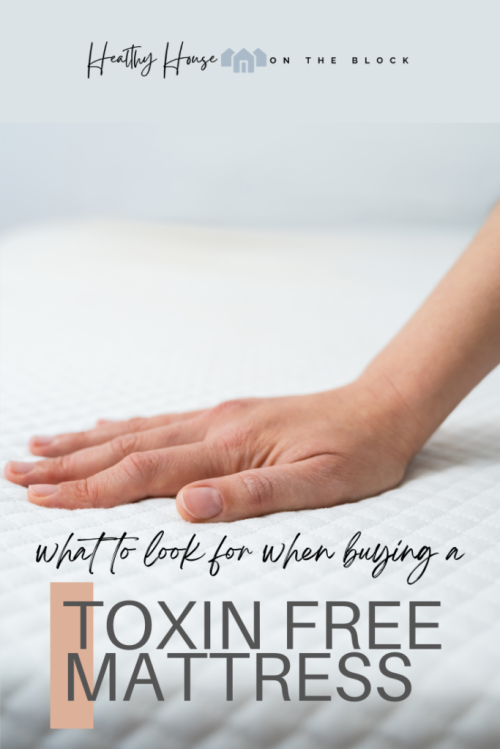
What we need most at night is a toxin free environment that will assist our bodies in repairing all the damage done during the day.
The second part of the equation is that whatever we are sleeping on becomes our direct environment for those hours of slumber. This means any chemical or toxin has direct contact with our skin for that time period. And what we know about our skin is that not only is our largest organ, but it also absorbs what it comes in contact with. (Source) Our skin is like the gateway to our internal systems in the fact that it carries both good and bad to our bloodstream.
But it’s not just our skin that draws in toxins while we are on our mattresses, it’s also our lungs. With our face in such close proximity to the mattress we’re sleeping on, VOCs and other toxins that off-gas are inhaled. And just like our skin, it’s a direct route to our bloodstream, which is then circulated to our entire body.
So imagine if a mattress is as free from toxins as possible, what the benefit could be for your body and your immune system.
WHAT TO AVOID
Flame Retardants: While being protected from the potential of a fire at night is important, is it much better to sleep on a chemical toxin for hours every day? Brominated flame-retardants, or BFRs, have been linked to a multitude of problems and disorders in the past few years. (Source). The United States has the highest levels of these flame retardants in our products and materials compared to other counties. These flame retardants also include PBDEs, which are known to disrupt the hormone and reproductive systems as well as influence behavior in some individuals.
With other options to help reduce the risk of flammability, it’s best to avoid all chemical flame retardants in mattresses.
Synthetic Latex: Synthetic latex is made from petroleum based compounds, which should be avoided when you’re trying to create a toxin free environment. In addition to the petroleum based compounds used, other toxic chemicals are also added during the manufacturing process to make the foam for mattresses. Synthetic latex also off-gasses because of the VOCs present in the chemicals. These VOCs disperse into the air around the mattress while you’re sleeping, meaning you’re breathing in all those toxins.
Styrene is also a petroleum based product that is in synthetic latex used, which is a possible carcinogen. In addition to being carcinogenic, Styrene affects the central nervous system and kidneys negatively. (Source)
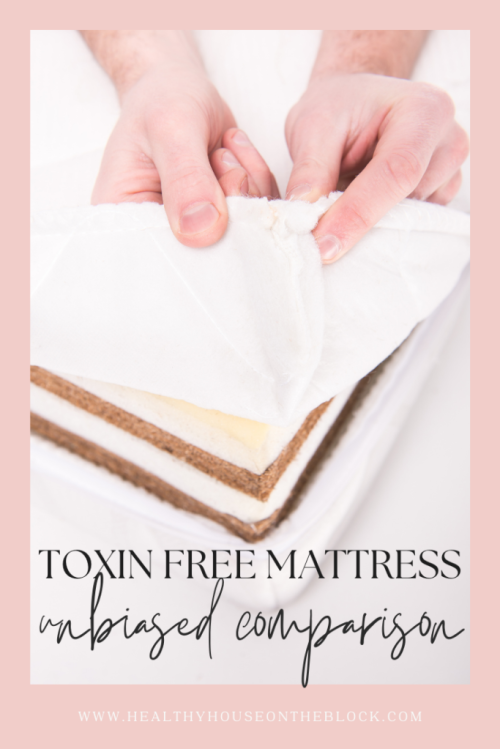
Vinyl and PVC: Polyvinyl chloride, or PVC is used in producing plastics, like waterproof protectors built for or onto mattresses. The toxins that are in PVC usually contain high levels of chlorine, which we know from studies is hazardous to health. (Source)
PVC also contains the same chemicals as flexible plastics, phthalates. We know that phthalates are to be avoided wherever possible as they linked to reproductive problems, disruption in hormones and possible cancer risk. (Source)
Synthetic Fragrances: With all of the chemicals that are used to make a mattress, often times there can be a strong chemical odor. In order to cover this smell and make a mattress more appealing to lay on, synthetic fragrances are usually added. Yikes! You can read more about synthetic fragrances here. But basically, fragrances that don’t come from natural sources are made of petrochemicals, or crude oil. The ingredients used to make the scent are then absorbed into our bloodstream and travel through our body, affecting our systems. In particular, it affects the endocrine system and can ultimately affect reproduction. (Source)
For me this falls into the category of , “I had no idea!”. But there it is. It’s just another reason we have to be so diligent in doing the research before trusting what any company or product is touting as a great product.
Chemical Antimicrobials: Added as a “benefit” to any mattress, these synthetic antimicrobials are intended to keep a mattress clean from microbes. But let’s be completely real here: We live in a world where over-sanitizing is definitely a thing. I’m guessing that your mattress will be sitting in a pretty clean environment in the first place, so really using a chemical antimicrobial is ultimately having the opposite effect. (Source)
By using a chemical antimicrobial, we’ve created this problem of breeding stronger bugs and bacteria. It’s the idea behind the superbug. Using a natural antimicrobial material is a much better option as well as just cleaning your mattress and with baking soda and keeping it dry. (Source)
Petroleum Based Foam: This is Polyurethane and often times memory foam. These are petrochemicals and emit harmful VOCs. Even mattresses who boast that they’re made of plant based foams emit VOCs, just like polyurethane foam. Polyurethane foam often times contains flame retardants right in the foam, which as mentioned above, should be avoided. But polyurethane also releases toxic toluene into the air, which is also in gasoline fumes, vehicle exhaust and cigarette smoke. (Source) (Source)
In addition to the foam itself being toxic, there are also glues used in the manufacturing process to bond the inner layers of the foam, mattress components and fabrics together. As you might already know, standard glues and adhesives contain VOCs as well as formaldehyde that off-gas for the entire life of the product. Specifically, these adhesives and glues have been linked to cancer, heart damage, nervous system problems, and liver and kidney issues. (Source)

WHAT TO LOOK FOR IN AN AFFORDABLE NON TOXIC MATTRESS

GOTS (Global Organic Textile Standard) Certification: One of the best certifications you can find when it comes to organic textiles and fibers. The criteria covers the processing, manufacturing, packaging, labeling, trading and distribution of fabrics with this certification. Textiles must be made from at least 70% certified organic fibers. These fibers must follow strict mandates during the processing and manufacturing process. Restrictions from use of synthetic compounds like PVC, chlorine, heavy metals, formaldehyde and solvents are just one of the ways they protect the product being made.

GOLS (Global Organic Latex Standard) Certification: This certification has strict requirements for latex that is made from organic, raw materials. To achieve this certification, a product must contain more than 95% of certified organic raw material. It also must pass an emission test ensuring the fewest number of harmful substances. This certification outlines a very clear procedure from the farmer or field level to the manufacturing process. Any product with this logo has to follow mandatory social and environmental regulations as well.
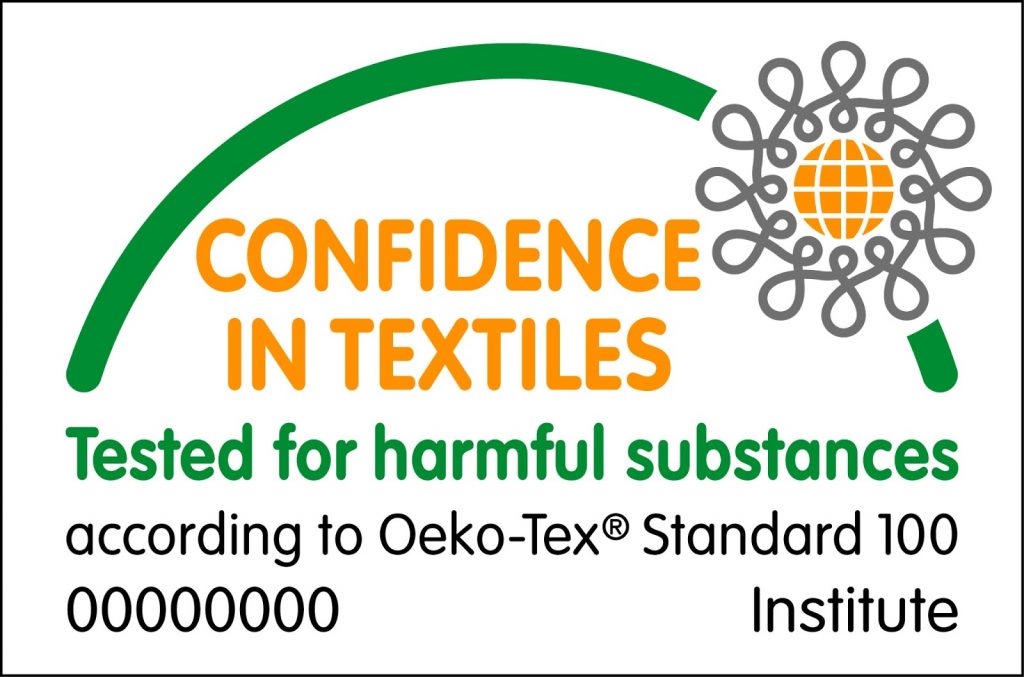
Oeko-Tex Standard 100 Label: This certification is for more than just the textiles used, but also has requirements for additional components of a product including thread, accessory parts and coatings on the product. They require products made from organic cotton without the use of harmful chemicals at any stage of production. Their Product ClassIV covers mattresses in their decorations/furnishings standard requirements.

MADESAFE: This certification means that the materials used to make the mattress are made from materials that are safe and are not known to harm human health or the environment. It looks at all the ingredients and materials used to make the mattress, however does not test the materials nor does it look at the manufacturing process.

Greenguard Gold: This certification is for more than just the textiles used, but also has requirements for additional components of a product including thread, accessory parts and coatings on the product. They require products made from organic cotton without the use of harmful chemicals at any stage of production. Their Product ClassIV covers mattresses in their decorations/furnishings standard requirements.
Natural and Organic Based Latex Based Foam: With the proper certifications, you can be assured that this is a chemical free option that contains no chemical properties. Natural latex is derived from the bark of rubber trees. Natural latex is naturally hypo-allergenic and helps regulate temperature as you sleep. Another benefit is that natural latex foam is naturally flame resistant, eliminating the need for additional chemical flame retardants.
Organic Cotton: Organic cotton is grown without the use of pesticides or synthetic fertilizers. In general, organic cotton is a non-irritant as no bleach or chemicals are used in the processing of the product. Cotton has a high level of breathability, which helps your mattress stay dry instead of trapping moisture in the fibers, which can lead to problems with bacteria. It also helps naturally keep your mattress and sleeping environment cool.
Organic Wool: Wool is a great material for mattresses, and has been used for many generations. Wool is a renewable resource from sheep and has many beneficial properties when it comes to a mattress. Sheep’s wool is naturally flame resistant and keeps bedding naturally drier than other materials as it is moisture-wicking. This means it naturally resists mold and mildew.
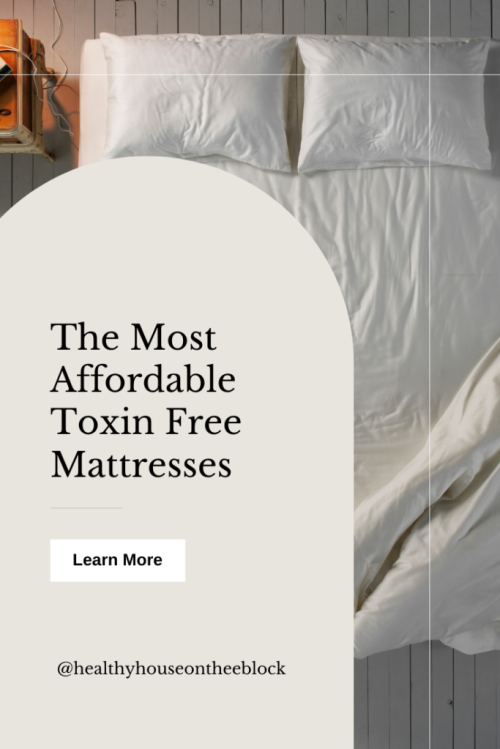
Natural and Organic Based Latex Based Foam: With the proper certifications, you can be assured that this is a chemical free option that contains no chemical properties. Natural latex is derived from the bark of rubber trees. Natural latex is naturally hypo-allergenic and helps regulate temperature as you sleep. Another benefit is that natural latex foam is naturally flame resistant, eliminating the need for additional chemical flame retardants.
THE BEST BRANDS FOR AN AFFORDABLE NON TOXIC MATTRESS
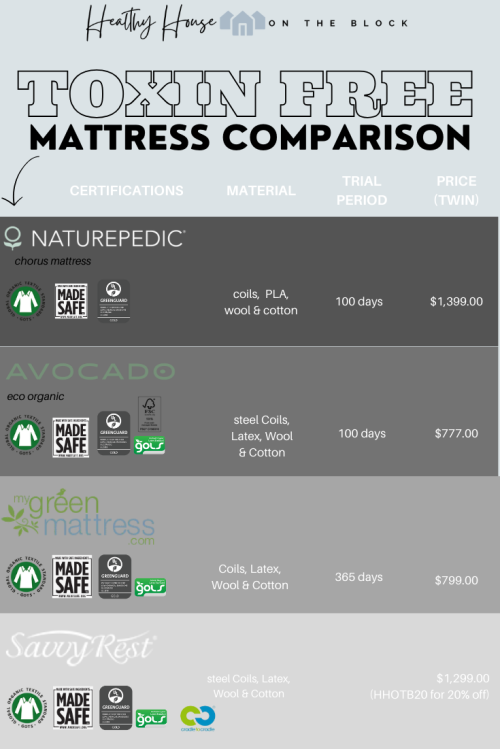
NaturePedic has been around for a long time and is a well-established company. Their chorus mattress is designed to keep air flowing from the top to bottom of the mattress in order to create a cooler space for sleeping. The cotton and wool batting and cover is made of GOTS certified materials. This mattress does not contain any latex and instead uses PLA, which is a synthetic fiber made from non-GMO sugar can to help with moisture wicking. Naturepedic mattresses are certified that they use no glues or polyurethane in the products. They hold the MadeSafe certification as well as the Greenguard Gold Certification.
Avocado Eco Green Organic Mattress is a great option as it holds both GOTS and GOLS certifications. They use 100% natural and organic latex, wool and cotton to make up the layers of the organic mattress. They’re also Greenguard Certified and MadeSafe Certified. They don’t use any formaldehyde in their solvents and use ethically harvested latex and wood for their other products. The steel springs they use in various areas of the organic mattress are made from recycled steel and encapsulated in fabric.
They also have a vegan mattress option, which is different from their green mattress in the sense that it uses just cotton and no wool.
MyGreen Mattress doesn’t use any polyurethane foams and their organic mattresses don’t contain any sort of flame retardant in them. Instead, they’re made up of GOTS certified wool and cotton in the outer layer and in the batting. They also use latex, which is organic and GOLS certified. They’re products are made in the USA and they have earned the MadeSafe Certification as well as the Greenguard Gold certification for their products.
Savvy Rest is a small company that hand-crafts all of their mattresses. They are made of organic, GOLS certified latex on the interior and a GOTS certified outer layer of cotton and wool. The mattress does contain encapsulated coils and they also have earned the MadeSafe Certification as well as the Greenguard Gold Certification for their products. SavvyRest uses extremely safe manufacturing practices and uses high quality materials like natural talalay rubber.
USE CODE HHOTB20 FOR 20% OFF ANY SAVVY REST PURCHASE
HEALTHY MATTRESS CARE
Cleaning: There are so many great ways to clean your mattress. And getting in the habit of doing so every couple months is a great idea. One of the ways you can get your mattress smelling fresh and clean is by sprinkling baking soda on the mattress itself. Let it sit for 15-20 minutes and then vacuum it up.
Zipped Cover: Using an all natural mattress cover can help protect your mattress from sweat, dust and other things that may come in contact with your mattress. Let’s remember we’re spending about a third of our life sleeping, so our mattresses are definitely being used! (THIS IS MY RECOMMENDED MATTRESS COVER)
Finding a cover that is both natural and has a zipper is best as it will fully encapsulate the mattress itself and protect. Also look for a cover that can be machine washed and get in the habit of washing it every so often with your sheets.
Rotate: Make sure you’re rotating your mattress every so often to ensure your wearing it out evenly. No one wants a divot in the middle of the mattress or at one end. By rotating it ever six to eight weeks, you can avoid this problem all together.
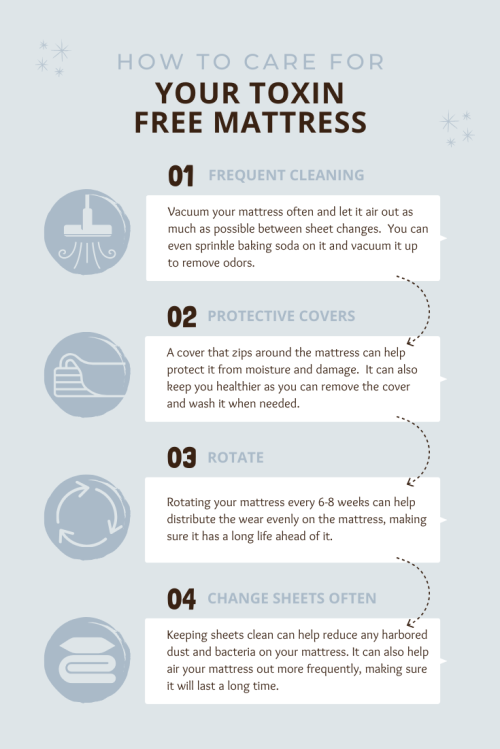
Change Your Sheets: Keeping your sheets clean and rotated is a very important part of mattress health. Sheets are protecting your mattress and if not changed frequently, can harbor dust and bacteria. Getting into the habit of washing your sheets every 1-2 weeks is ideal. And then make sure your washing them in an all natural laundry detergent.
Remember that an organic mattress is oftentimes a HUGE purchase and can feel overwhelming. But all you really need to do is know what to look for and then watch for sales when you’re ready to buy. Creating a toxin free sleeping space is one of the most impactful ways we can create a healthy home and sleep sanctuary.
Share this:
- Click to share on Facebook (Opens in new window) Facebook
- Click to share on LinkedIn (Opens in new window) LinkedIn
- Click to share on Reddit (Opens in new window) Reddit
- Click to share on Pinterest (Opens in new window) Pinterest
- Click to print (Opens in new window) Print
- Click to share on X (Opens in new window) X



Shopping for a mattress is seriously one of the hardest things to do, especially because you’re generally having to accommodate two people’s comfort. Thanks for breaking down what to look for and also some suggestions on where to start.
That really can be the trickiest part! My husband and I have VERY different tastes in mattresses and what our preferences are, so finding a balance take a little time of shopping around.
Thanks for the advice – I hadn’t considered that my mattress might be toxic! We’re renewing ours shortly so will bear this in mind!
I’m glad it was useful information Kate!
I’ve recently started thinking about this! I went to buy a pillow cover and couldn’t find one without fire retardant. Bleh. I’d never really thought about looking for an organic, natural mattress – thank you! I’ll have to save up for one but they look really nice.
It’s tough to find products without flame retardants — you kind of have to hunt for them. But it’s worth it in the end 🙂
I’ve been trying to eliminate chemicals and toxins in our home, but I never even thought about the mattress! We aren’t ready to replace ours yet, but I will definitely be taking it into consideration the next time we do!
It’s one of those purchases we don’t think about too often because we use them for so long! I’m glad it was helpful for you, Stephanie! 🙂
We use a foam mattress. No idea though if it is petroleum-based. I”ll need to look into it.
I’m glad it had some helpful information for you to use!
Such an important topic! Our sleep is just as important as our diet when it comes to maintaining our health and vibrancy. I only started making sleep a priority about 4 years ago. What a difference! Two years ago we switched to a natural latex mattress (from a toxic memory foam) and got a wool mattress topper for it. I lOVE going to bed now. I am so comfortable and I am never too hot. Between that and my bedtime routine, I almost always have an amazing night’s sleep.
Oh my gosh — it does make such a difference, doesn’t it!? I feel like I can conquer the world when I get a good night of sleep too. Plus it has to be good for preventing those wrinkles and fine lines 🙂
Great tips on finding a new mattress.. I really think I need a new one to have good night sleep.
That’s why we ended up getting a new mattress a few years ago, and it really did help with our sleep. Hope it does for you too!
We are in the process of buying a new bed and mattress, so this is super helpful! I am going to try out that cleaner on our current mattress.
I’m glad! Thieves cleaner is the true Jack-of-all-Trades!
Thank you so much for this information! I want an organic and non-toxic mattress SO BAD but it’s just not in the budget right now. I also had no idea that Oeko-Tex Standard 100 Label requires organic cotton! That’s really good to know!
You’re so welcome, Emily! I’m glad it was information you could use!!
I never thought about getting a non-toxic mattress. I actually never even considered the toxins in my mattress! Now I am going to use your advice to shop!
I hope it helps you pick out a great mattress at least 🙂
Too bad I haven’t come across your article a month ago when we bought a new mattress. There is so much useful information here I didn’t know about. The only thing I had in mind was to avoid synthetic and look for more cotton and memory foam. I never rotated my mattresses but I will do that from now on. Thanks for sharing!
You’re welcome! I’m glad it’s still beneficial information for you!
Ha, that’s a lot of hours sleeping. Making sure we have the right mattress really does matter in so many ways.
It really is!! 🙂
Great tips for taking care of your mattress. I need to get better at practising this advice.
Me too! Easier said than done sometimes 🙂
I just learned SO MUCH! I’ll be needing a new mattress within the year and after reading this my perspective while shopping will be completely different!
I’m so glad you found this useful, Christa! Such a great change you can make for your home!
This product is not helpful for those of us who are deathly allergic to avocado and latex !!
Notify me when you have a product that is healthy without latex and not green.
In the post about pillows, Amanda mentions that buckwheat pillows are an option. I learned a few years ago that they’re also an option for mattresses as well!
Could that maybe be a good match?
Great information! Do the zippered covers or mattress pads protect you from chemicals in the mattress?
Most probably don’t protect you from off-gassing, but it could help with particles that could come loose from the mattress over time.
Pingback: Sleep Sanctuary: Kids' Edition (the best way to fall asleep)
Pingback: Bedroom Ideas to Reduce Toxins » Healthy House on the Block
Pingback: Healthy Home Expert: Microbiome Disrupting Chemicals: How to Avoid This New Class of Chemicals
Pingback: Natural and Organic Bedding Guide - Healthy House on the Block
Pingback: Year End Healthy House Review: Looking Ahead to 2024 -